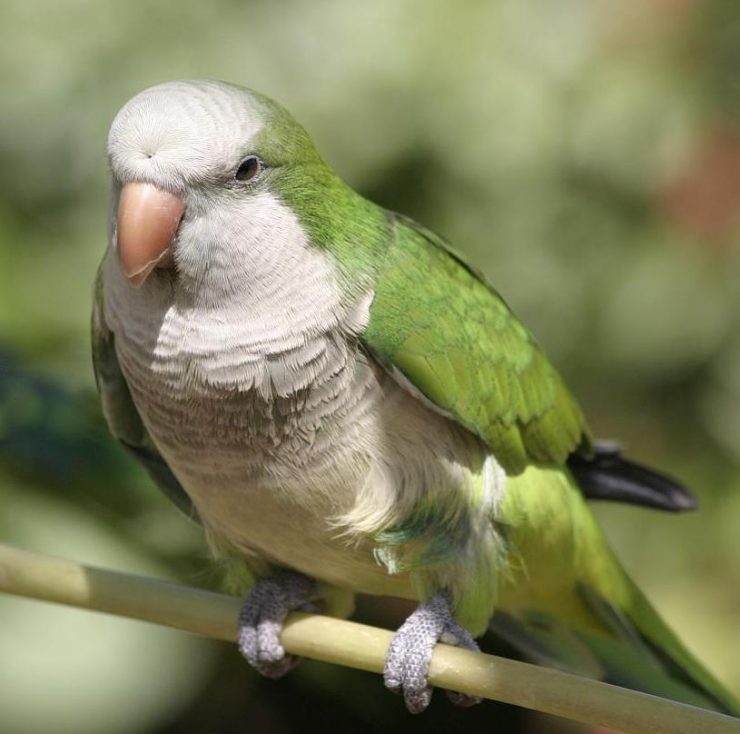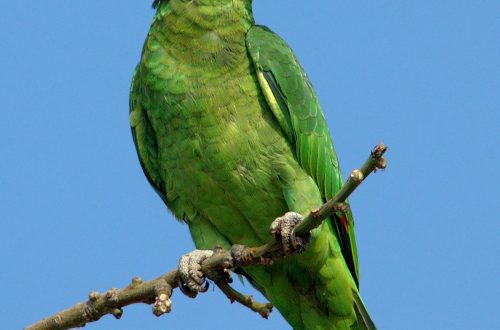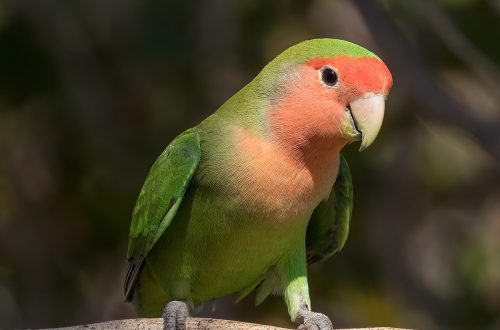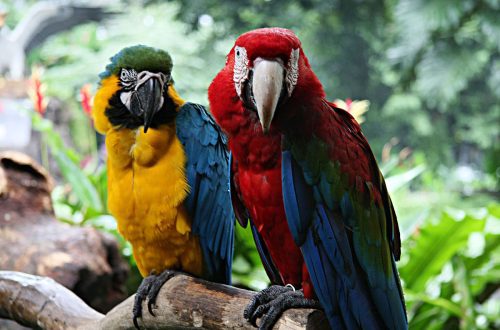
Kalita, or parrot, is a monk
In the photo: Kalita, or monk parrot (Myiopsitta monachus)
Order | Parrots |
family | Parrots |
Race | Kalita |
Contents
Appearance
Kalita, or monk parrot, is a medium parrot with a body length of about 29 cm and a weight of up to 140 grams. The tail is long, the beak and paws are powerful. The plumage color of both sexes is the same – the main color is green. The forehead, neck, chest and belly are grey. On the chest there are barely noticeable transverse stripes. The wings have an olive tint, flight feathers are blue. Undertail olive-yellow. Tail feathers are green. The beak is flesh-colored. Paws are grey. The eyes are brown. The species includes 3 subspecies, which differ from each other in color elements and habitat. Life expectancy with proper care is about 25 years.
Habitat and life in nature
The kalit species, or monk parrot, lives in northern Argentina, Paraguay, Uruguay, and southern Brazil. In addition, the monks have created introduced populations in the USA (Alabama, Connecticut, Delaware, Florida, Illinois, Louisiana, New York, New Jersey, Oregon, Rhode Island, Texas and Puerto Rico), Bedfordshire and Alfreton, Great Britain, the Netherlands , France, Italy, Belgium, Spain and the Canary Islands. They adapt very well not only to cities, but even to cold climates and are able to overwinter in Europe. In its natural range it is found in dry wooded areas, in savannahs, visits agricultural lands and cities. It lives at an altitude of up to 1000 m above sea level. They feed on various seeds, both wild and agricultural. The diet also contains fruits, vegetables, berries, cactus shoots, and various other fruits. In addition, the larvae of some insects are eaten. They feed on the ground and on trees. They usually live in flocks of 30-50 birds. Outside the breeding season, they can stray into huge flocks of up to 200 – 500 individuals. Often combined in flocks with other bird species (pigeons).
Reproduction
The nesting season is October-December. This species is unique in that it is the only one of the entire order that builds real nests. Monks usually nest colonially. Usually several pairs build one large nest with many entrances. Sometimes such nests can reach the size of a small car. Birds use tree branches to build nests. Outwardly, the nest resembles that of a magpie, but many times larger. Often these nests are inhabited by other species of birds, as well as some mammals. Nest building takes quite a long time, sometimes up to several months. Often nests are used for sleeping in the cold season. Usually nests are used for several years in a row. The male and female actively mate after construction, then the female lays 5-7 eggs and incubates them for 23-24 days. The chicks leave the nest at 6-7 weeks old. Usually, for some time, young birds stay close to their parents, and they are supplemented by them for several weeks.
Maintenance and care of the kalita, or monk parrot
These parrots are quite unpretentious for keeping at home. However, it should be borne in mind that not every bird lover may like their voice. They scream quite loudly, often and piercingly. They have a fairly powerful beak, so the cage or aviary should be well locked. These birds will easily gnaw through a thin mesh, as well as the wooden base of the cage. Their beak is also able to reach other wooden objects outside the cage. The ability to imitate the speech of the monks is quite impressive. They are very smart, capable of learning and quite easily tamed and long lived. Several color mutations have been bred – blue, gray, white, yellow. Monks, when conditions are created, breed well in captivity. By nature, these birds are colonial, therefore they quickly find a common language with other parrots, but sometimes they can be aggressive towards smaller representatives, especially if they encroach on their home. Strong spacious cages are suitable for keeping monks. The best choice would be an aviary. The cage should have strong perches with bark of the correct diameter, bathing suit, toys. These birds love to climb, play, so the stand will be a great way to entertain these parrots. Birds love and require long walks, with a sedentary lifestyle, they are prone to gaining excess weight.
Feeding the Kalita, or Monk Parrot
To create a diet, it is necessary to use a grain mixture for medium parrots, which will include various types of millet, canary seed, a limited amount of sunflower seeds, oats, buckwheat and safflower. The grain mixture can be replaced with special granular feed, to which the bird should be accustomed gradually. Green foods must be present in the diet every day – various types of lettuce, chard, dandelions, wood lice and other herbs. From fruits, offer an apple, pear, citrus, cactus fruit, grapes, bananas. From vegetables – carrots, corn, beans and green peas. Sprouted seeds and berries are well eaten. Nuts can only be offered to monks as a treat. Branch food should be constantly in the cage. Sources of calcium and minerals should be present in the cage – sepia, mineral mixture, chalk, clay.
Breeding
Despite the fact that the monks build nests in nature, at home they breed well in special nesting houses. The size should be 60x60x120 cm. It should be installed after proper preparation of the birds. To select a pair, you can use a DNA test to determine the sex or observe the behavior of birds. Usually females are smaller than males. Birds should not be relatives, they should be active and healthy. Manual birds breed poorly, as they perceive a person as their partner. It is necessary to increase daylight hours to 14 hours, the diet should be very varied, it is also necessary to include animal feed and more germinated seeds. In captivity, males can take part in the incubation of masonry along with the female. After the chicks of the kalita, or monk parrot, leave the nest, the parents will look after and feed their offspring for some time until they are completely independent.





